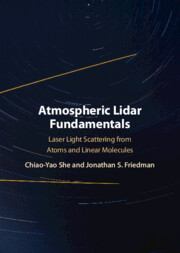Book contents
- Atmospheric Lidar Fundamentals
- Atmospheric Lidar Fundamentals
- Copyright page
- Dedication
- Contents
- Foreword
- Preface
- 1 Introduction
- 2 Classical Light Scattering Theory
- 3 Semiclassical Treatment of Light Absorption and Scattering from Atoms
- 4 Rayleigh and Raman Scattering from Linear Molecules
- 5 Introduction to Lidar Remote Sensing and the Lidar Equation
- 6 Common (Broadband) Lidar Types and Associated Applications
- 7 Lidars for Profiling Aerosol Optical Properties, Atmospheric Temperature and Wind
- 8 Transmitting and Receiving Optics
- Book part
- Index
- References
2 - Classical Light Scattering Theory
Published online by Cambridge University Press: 24 February 2022
- Atmospheric Lidar Fundamentals
- Atmospheric Lidar Fundamentals
- Copyright page
- Dedication
- Contents
- Foreword
- Preface
- 1 Introduction
- 2 Classical Light Scattering Theory
- 3 Semiclassical Treatment of Light Absorption and Scattering from Atoms
- 4 Rayleigh and Raman Scattering from Linear Molecules
- 5 Introduction to Lidar Remote Sensing and the Lidar Equation
- 6 Common (Broadband) Lidar Types and Associated Applications
- 7 Lidars for Profiling Aerosol Optical Properties, Atmospheric Temperature and Wind
- 8 Transmitting and Receiving Optics
- Book part
- Index
- References
Summary
In Chapter 2, we present classical light scattering theory. We show the classical electric dipole and how it leads to a model of atomic polarizability and differential scattering cross section. This leads us to the two principal divisions of atomic and molecular scattering, resonant and nonresonant. From here, we close with the causes of broadening of the scattering spectrum, as compared to the laser excitation.
Keywords
- Type
- Chapter
- Information
- Atmospheric Lidar FundamentalsLaser Light Scattering from Atoms and Linear Molecules, pp. 7 - 16Publisher: Cambridge University PressPrint publication year: 2022

